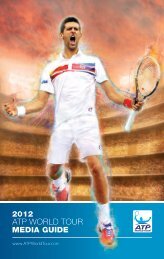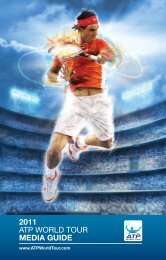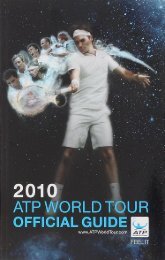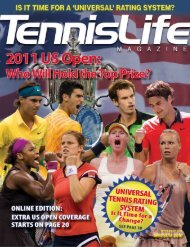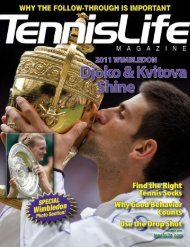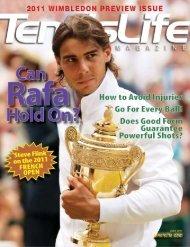The tennis drill book-2e
www.tennismoscow.me Insta:TENNISMOSCOW
www.tennismoscow.me Insta:TENNISMOSCOW
- No tags were found...
You also want an ePaper? Increase the reach of your titles
YUMPU automatically turns print PDFs into web optimized ePapers that Google loves.
4 <strong>The</strong> Tennis Drill Book<br />
Since the 1970s and ’80s, grips and gripping techniques have changed dramatically.<br />
In those years, most players used the Eastern and Continental grips<br />
for every stroke, giving the ball lots of power but not much spin or variety.<br />
<strong>The</strong> current era of <strong>tennis</strong> commands a much more dramatic use of grips in<br />
order to stay on top of the changing pace and spin of the ball. Using semi-<br />
Western to full Western forehand and backhand grips is essential for competing<br />
against the pace, spin, and power that players use today. Changing<br />
the position of the hand or hands on the grip causes the angle of the racket<br />
face to change, thereby causing the ball to spin in a direction that creates<br />
topspin (forward), backspin (backward), or slice or sidespin (horizontal).<br />
To become more consistent and hit with controlled power, players put more<br />
topspin on the ball. To create a more penetrating and effective volley, players<br />
put backspin on the ball.<br />
Players often overlook one aspect of gripping; that is, why the grips do<br />
what they do. Whether a player chooses an Eastern or full Western grip,<br />
the part of the hand that has greater grip control determines the depth of<br />
the shot. <strong>The</strong> palm has two ways to grip the racket: with the forefinger and<br />
thumb or with the little, ring, and middle fingers. Using the forefinger and<br />
the thumb together is called using the pinchers. <strong>The</strong> bottom three fingers<br />
are called the squeezers. To achieve greater depth with the forehand and<br />
backhand, players tighten the squeezers on the forward swing. For a sharp<br />
crosscourt shot, they use the pinchers. On the forehand, the squeezers are<br />
the ones controlling and tightening (which turns the grip into the Eastern<br />
forehand). On the backhand, the pinchers are the control fingers (index and<br />
thumb), and help add subtle underspin. For the serve, the grip is held loosely<br />
on the backswing. As the racket lifts to the point of contact, the pinchers<br />
tighten, rotating the forearm and snapping up to the ball for control, feel,<br />
and placement. For the volley, the Continental grip is preferred. However,<br />
using the squeezers (the last three fingers on the racket hand) and the pinchers<br />
changes the face of the racket.<br />
When players investigate the various types of grips and learn how to find<br />
and use them properly, with practice they can eventually use them to build<br />
a more consistent, powerful game with reliable groundstrokes. Learning to<br />
manipulate the grips of today's <strong>tennis</strong> requires excellent timing, balance,<br />
footwork, practice, and loads of patience. When you first teach young <strong>tennis</strong><br />
players (players under the age of 10) how to grip the racket, you’ll notice<br />
that sometimes the most natural way is to use the semi-Western grip on the<br />
forehand and two-handed grip on the backhand. Let them go for it. Using<br />
QuickStart <strong>tennis</strong> balls, a mini <strong>tennis</strong> net, and smaller court dimensions,<br />
your young players will be able to hit with topspin within months instead<br />
of years. <strong>The</strong>y will already have a greater advantage in the progression of<br />
their <strong>tennis</strong> game from day one.<br />
<strong>The</strong> <strong>drill</strong>s in this chapter will help players to make the small changes<br />
necessary to take their game to the next level. Above all, players must know<br />
that the best grip is the most comfortable one. <strong>The</strong> player or instructor must<br />
decide which grip works best for the stroke or spin the player is trying to hit.






